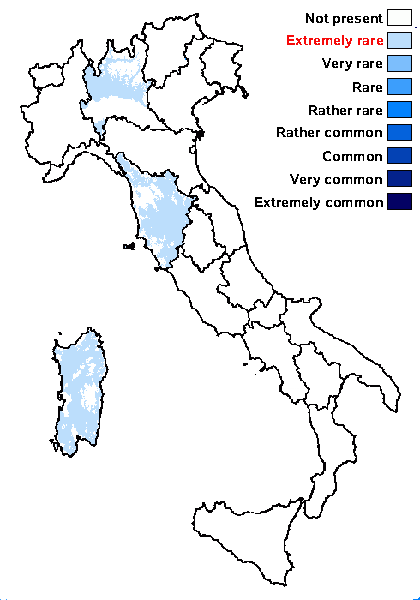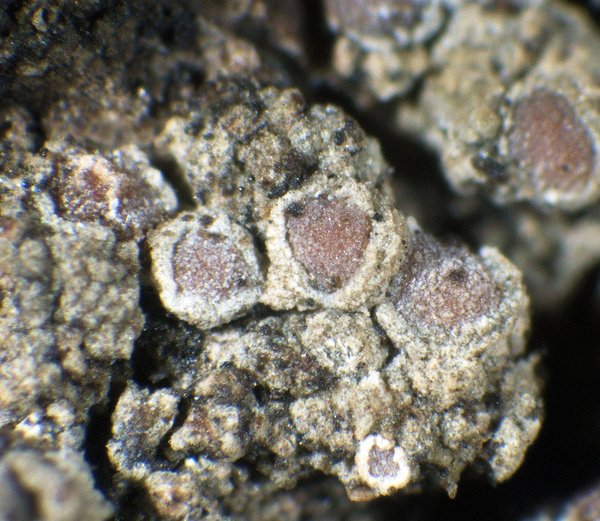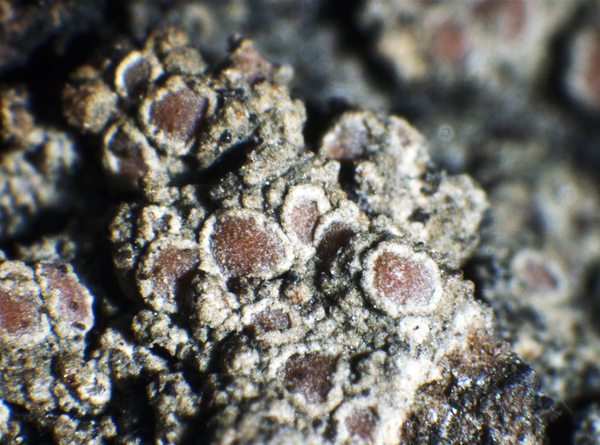Lecanora quercicola Coppins & P. James
Lichenologist, 11: 145, 1979.
Synonyms:
Distribution: N - Lomb (Zocchi & al. 1997). C - Tosc, Sar (B 60 0153517, det Z. Palice).
Description: Thallus crustose, episubstratic, rimose-areolate to warted, rarely granular, yellowish grey, grey or pale grey-brown, without a distinct prothallus. Apothecia lecanorine, 0.2-0.5 mm across, with a flat to slightly convex, pale brown, grey brown or pale reddish brown, often faintly pruinose disc, and an often slightly paler, persistent, more or less crenulate thalline margin. Thalline exciple thinly corticate, the outer rim c. 20 μm wide, filled with granules; proper exciple often evident, yellowish, pseudoparenchymatous in inner part; epithecium yellowish to brown, N-, filled with yellowish granules; hymenium colourless, 40-50(-65) μm high; paraphyses mainly simple, (1.5-)2-2.5 μm thick at mid-level, the apical cells up to 3.5 μm wide; hypothecium colourless. Asci 8-spored, broadly clavate, Lecanora-type. Ascospores 1-celled, hyaline, narrowly ellipsoid, 8-10(-12) x 4-5 μm. Pycnidia of 2 types: a) 90-100 μm wide macropycnidia producing slightly curved, 8-12 x 2.5-3(-3.5) μm macroconidia (always present), b) to 70-90 μm wide micropycnidia producing 10-11 x c. 0.5 μm, curved, pointed microconidia (rare). Photobiont chlorococcoid. Spot tests: thallus K-, C-, KC-, P-, UV+ grey-white. Chemistry: isousnic acid, variable amounts of neousnic acid.
Note: on well-lit boles of ancient deciduous trees (e.g. Quercus, Castanea); mainly Tyrrhenian, but also reported from the Austrian Alps. It is included in the Italian red list of epiphytic lichens as “Critically Endangered” (Nascimbene & al. 2013c).
Growth form: Crustose
Substrata: bark
Photobiont: green algae other than Trentepohlia
Reproductive strategy: mainly sexual
Most common in areas with a humid-warm climate (e.g. most of Tyrrenian Italy)
Commonnes-rarity: (info)
Alpine belt: absent
Subalpine belt: absent
Oromediterranean belt: absent
Montane belt: absent
Submediterranean belt: extremely rare
Padanian area: absent
Humid submediterranean belt: extremely rare
Humid mediterranean belt: absent
Dry mediterranean belt: absent

Predictive model
Herbarium samples
Growth form: Crustose
Substrata: bark
Photobiont: green algae other than Trentepohlia
Reproductive strategy: mainly sexual
Most common in areas with a humid-warm climate (e.g. most of Tyrrenian Italy)
Commonnes-rarity: (info)
Alpine belt: absent
Subalpine belt: absent
Oromediterranean belt: absent
Montane belt: absent
Submediterranean belt: extremely rare
Padanian area: absent
Humid submediterranean belt: extremely rare
Humid mediterranean belt: absent
Dry mediterranean belt: absent

Predictive model
| Herbarium samples |
 Index Fungorum
Index Fungorum
 GBIF
GBIF




